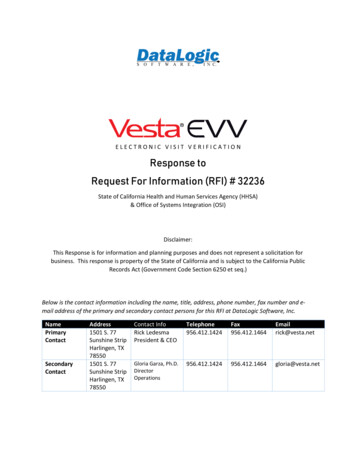
Transcription
ELECTRONIC VISIT VERIFICATIONResponse toRequest For Information (RFI) # 32236State of California Health and Human Services Agency (HHSA)& Office of Systems Integration (OSI)Disclaimer:This Response is for information and planning purposes and does not represent a solicitation forbusiness. This response is property of the State of California and is subject to the California PublicRecords Act (Government Code Section 6250 et seq.)Below is the contact information including the name, title, address, phone number, fax number and email address of the primary and secondary contact persons for this RFI at DataLogic Software, Inc.NamePrimaryContactSecondaryContactAddress1501 S. 77Sunshine StripHarlingen, TX785501501 S. 77Sunshine StripHarlingen, TX78550Contact InfoRick LedesmaPresident & esta.netGloria Garza, ria@vesta.net
Response to RFI#32236Table of Contents1.INTRODUCTION . 131.11.11.31.4Executive Summary. 13Company Background . 15History with Medicaid . 15Management Team . 182. VESTA EVV . 202.12.3Overview . 20Vesta EVV Components . .102.3.112.3.122.3.132.3.142.3.152.4Vesta Additional Features . 242.4.12.4.22.4.32.4.42.5Vesta EVV Value-Added Features.24Vesta Data Security Features .24Reporting & Analytics .24Vesta EVV Visit Maintenance .25Vesta EVV Additional Considerations .262.5.12.5.22.5.3.2.5.42.5.52.5.72.5.82.62.7Vesta EVV Devices .21Vesta Interactive Voice Recognition Application .22Vesta Mobile Application .22Vesta Token Manager .22Vesta EVV Complete Management System .22Vesta EVV Only Management System .22Vesta EVV Web Application for Self-Directed Individuals .22Vesta Visit Monitor for State Agencies & Managed Care Organizations .22Vesta Biller .22Vesta Payroll .23Vesta Third-Party Web Service .23Vesta Eligibility Validation System .23Vesta Authorization Validation System .23Vesta EVV Data Distribution Service .23Vesta Secure EVV Storage Data Center .23Customer Satisfaction .26Vesta EVV Administrative Burden Reduction .27Individuals With Special Circumstances .27Contingency Plans for Network Outages .28Typical Implementation Process per Provider .28Ease of Use .29Technology Updates .29Covered Programs and Population Characteristics . 30Implementation Models. 312.7.1 Option 1 – Individual Provider Model Leveraging Existing Infrastructure .322.7.2 Option 2 – Individual Provider Model Replacing Existing Infrastructure .332.7.3 Option 3 – Agency Provider Model .34Page 2 of 46
Response to RFI#322362.7.4 Option 4 – Replace Time Sheet processes and major components of payrollprocessing .352.7.5 Option 5 – Expand Solution To Home Health Agency Model.362.7.6 Pros & Cons of Leveraging Existing ETS System .372.7.7 Lessons Learned .372.7.8 EVV Models .372.7.9 Vesta EVV Implementation Process .402.82.9Cost Structure . 42Summary . 433. APPENDIX . 443.13.2HHSC Contact Information . 44Documentation . 44REFERENCE . 464.14.2Glossary. 46Sources. 46Page 3 of 46
Response to RFI#32236List of TablesTableABCDEFGHITitleStatewide Implementation ChangesVesta EVV MetricsVesta EVV Growth in TexasTypical Agency Provider SetupTypical Self-Directed Provider SetupTexas and California Comparative MetricsSample Project Work PlanSample Communication PlanSample Training PlanPage162026282830404141Page 4 of 46
Response to RFI#32236List of FiguresFigure123TitleDataLogic Organizational ChartNumber of Providers using Vesta EVV in TexasNumber of Recipients in Vesta EVV in TexasPage182627Page 5 of 46
Response to RFI#32236List of AcronymsAcronymTermALWAssisted Living WaiverADLsActivities of Daily LivingCDSSCalifornia Department of SocialServicesCase Management Information andPayrolling System(California) Department ofDevelopmental ServicesCMIPSDDSDHCSETS(California) Department of HealthCare ServicesElectronic Timesheet SystemEVVElectronic Visit VerificationFIFiscal IntermediaryHCBAHome and Community-BasedAlternatives Waiver ProgramHCBSHHSAIHOHome and Community-Based ServicesCalifornia Health and Human ServicesAgencyTexas Health and Human ServicesCommissionIn Home Operations Waiver ProgramIHSSIn-Home Supportive ServicesHHSCDefinitionA California State program that waives institutional settingrequirements of federally funded care for individuals whoare at risk of being institutionalized or can be safelytransferred from an institution to a community setting.Basic self-care tasks, such as feeding, bathing, grooming,walking, dressing, meal preparation, laundry, etc.The State agency that manages IHSS Services in theIndividual Provider Model.The automated system administered through IHSS andWPCS which supports case management, and payroll.The State agency that manages RCs for Supported LivingServices, In-Home Respite, and Personal AssistanceServices as part of the HCBS program.The State agency that manages HCBS services in theAgency Provider Model.Electronic time tracking system that collects data for hoursworked.An electronic system to validate Medicaid service deliveryaccording to the 21st Century Cures Act.The organization that manages claims payments toProvider agencies for the California Department of HealthCare Services.A California State program that waives institutional settingrequirements of federally funded care for individuals whoprefer to receive long term services and supports in theirhome and community. Part of the WPCS.A program administered by DHCS.The State agency that consists of the CDSS, DHCS and DDS.The agency that oversees all Medicaid programs in theState of Texas.A California State program that waives institutional settingrequirements of federally funded care for individuals whoprefer to receive long term services and supports in theirhome. Part of the WPCS.One of four Medicaid programs managed by CDSSconsisting of Personal Care Services Program(PCSP). IHSS is58 counties across California and serves 550,000individuals.Page 6 of 46
Response to RFI#32236MFCUMedicaid Fraud Control UnitMSSPMultipurpose Senior Services ProgramOSI(California) Office of SystemsIntegrationPPCWPediatric Palliative Care WaiverRCsRegional CentersTDHSTexas Department of Human ServicesTPFTTSTimesheet Processing FacilityTelephone Timesheet SystemWPCSWaiver Personal Care ServicesAn entity of the state government, separate from theMedicaid agency, mandated to statewide programs forinvestigating Medicaid fraud.The MSSP Waiver provides Home and Community-BasedServices (HCBS) to Medi-Cal eligible individuals.The Office of Systems Integration is a department of HSSAthat was established to manage large, complex health andhuman services information technology projects.A pediatric palliative care program made possible througha 1915(c) (home and community based services or HCBS)waiver approved by the Centers for Medicare andMedicaid Services for use in California.California Regional Centers are non-profit organizationsthat contract with Individual Providers and AgencyProviders to provide supported living services, In-HomeRespite and Personal Assistance Services to individualswith developmental disabilities.Prior name of department that oversees Medicaidprograms, now called Texas Health and Human ServicesCommission (HHSC).Centralized facility where timesheets are mailed.A system for blind and visually impaired recipients to call aphone number and verbally approve the number of hoursworked by an employee for the recipient.Services authorized by the DHCS a, designed to assist ingaining independence for activities of daily living andpreventing social isolation.Page 7 of 46
Response to RFI#32236CROSS-REFERENCE MATRIX FOR RESPONSE FORMAT & CONTENTRFIREFERENCESECTION1RFI INFORMATIONResponses to Attachment A CMIPS RFI QuestionsResponseREFERENCESECTIONDescribe how your company delivers this type of electronic verificationsolution or service in similar Medicare and Medicaid settings, or othersimilar health care settings for consumer directed personal care and/orhome care service delivery. Include a description of the populationcharacteristics of individuals currently served by your system(s) andinclude the number of members.Provide a detailed description of the EVV system.Functionality of the system including the devices, methods of datacollection, technology and infrastructure requirements for bothindividuals receiving services (Recipients) and service providers(Providers), (e.g., land-line telephones, cell phones, in-home fixed device,tablet, internet, GPS).Describe how your EVV. WPCS Providers are family members and/or livein the household with the Recipient. WPCS Providers are family membersand/or live in the household with the Recipient.22cSecurity features of the system that confirms the identity of both theProviders and Recipients and how that data is kept secure.2.4.32dData collection, including information identified in this RFI Section 5Proposed Environment.2.3.142eFeatures that address the requirement that allows Providers to modify or“fix” information (i.e., if they forget to check in/out).2.4.42fFeatures that conform to the concept of being minimally burdensome.2.5.22gFeatures of the system that conform to the Americans with DisabilitiesAct (ADA) and address needs of special populations of Providers andRecipients, such as developmental disabilities and visual/hearingdisabled.2.72hFeatures of the system that address the needs of special populations thatcannot be near electronic devices.2.5.32iFeatures of the system that address the provision of EVV in rural areaswhere technology infrastructure may be limited or unavailable.2.3.12jAdditional features the system offers outside of EVV.2.3.8, 2.3.9,2.3.1022a2b222.2Page 8 of 46
Response to RFI#32236CROSS-REFERENCE MATRIX FOR RESPONSE FORMAT & CONTENTRFIREFERENCESECTION2kRFI INFORMATIONResponses to Attachment A CMIPS RFI QuestionsService level metrics including system availability and system y plans for system outages or unavailability.Flexibility of the system to implement changes and how quickly changescan be made. Describe how the system has built in flexibility such as theability to meet business needs or make changes through simpleconfiguration set up and/or configuration changes.2.5.42.4.2 2.52n2oTypes of analytics and reporting provided.Typical account set up time and check in/out time for Providers andRecipients.2.4.32.5.53Describe if/how the system groups or categorizes tasks to simplify systemoperation, tracking, Provider and Recipient use, etc.2.5.74Describe the system’s capability to interface with other systems, foreligibility, timekeeping, payroll or data collection purposes.2.3.115Describe your experience with implementing EVV systems including highlevel timelines for implementation and training for all user populations.2.12.7.95Describe implementation challenges and lessons-learned. Describe howto overcome implementation challenges.2.7.75Distinguish implementation(s) for government entities versus privateentities.1.1Paragraph 5,65If implemented for state entities, please identify which states and providecontact information.3.16Describe how to overcome implementation challenges inherent toCalifornia such as the change management for a large and vulnerablepopulation. Describe mitigation strategies that could be used to addresschallenges.2.87Discuss strategies you have employed to garner customer satisfaction andinclude any satisfaction survey data, if available.2.5Page 9 of 46
Response to RFI#32236CROSS-REFERENCE MATRIX FOR RESPONSE FORMAT & CONTENTRFIREFERENCESECTION8RFI INFORMATIONResponses to Attachment A CMIPS RFI QuestionsResponseREFERENCESECTION2.5Describe the response to your EVV from a wide range of Recipients andProviders with a wide range of disabilities including blind and deaf and/orlow literacy levels.910Discuss ongoing maintenance of EVV systems.Describe if/how the EVV Portal with the ETS feature and the pros andcons of doing so.2.5.82.7.711Describe how an EVV solution can be effectively implemented for boththe Individual Provider and Agency Provider employment models.2.7.1, 2.7.312Describe your business model (e.g., Software as a Service, Commercialoff-the-Shelf, Modified off-the-Shelf, custom built, transactional).2.113Describe the costs and fee structure of EVV, and other HCBS Waiverprograms. Differentiate between Individual Provider and Agency Provideremployment models. Identify both one-time and on-going costs. Describehow the cost model would scale up to accommodate the large number ofIHSS and WPCS Providers. and other HCBS Waiver programs. Differentiatebetween Individual Provider and Agency Provider employment models.Identify both one-time and on-going costs. Describe how the cost modelwould scale up to accommodate the large number of IHSS and WPCSProviders. and other HCBS Waiver programs. Differentiate betweenIndividual Provider and Agency Provider employment models. Identifyboth one-time and on-going costs. Describe how the cost model wouldscale up to accommodate the large number of IHSS and WPCS Providers.and other HCBS Waiver programs. Differentiate between IndividualProvider and Agency Provider employment models. Identify both onetime and on-going costs. Describe how the cost model would scale up toaccommodate the large number of IHSS and WPCS Providers.Describe how the EVV solution for personal care service that must beimplemented in 2019 could be expanded to accommodate the 21stCentury Cures Act home health care service EVV requirement by January1, 2023.2.7142.7.5Page 10 of 46
Response to RFI#32236CROSS-REFERENCE MATRIX FOR RESPONSE FORMAT & CONTENTRFIREFERENCESECTION15RFI INFORMATIONResponses to Attachment A CMIPS RFI QuestionsResponseREFERENCESECTION2.5.3Describe the different means of communication (e.g., notifications) thesystem is capable of producing such as letters, e-mail, text, and phone inmultiple language formats for visually and hearing disabled includinglarge font, braille, and audio text.16Describe how your system is kept current and how it keeps up withtechnology changes.2.5.81Option 1.Leverage IHSS Provider Model.For the Individual Provider model, the EVV solution or service couldleverage existing IHSS Portal components for the ETS or TTS. When theProvider works for the Recipient, the EVV could automatically collect datafor hours worked and record services provided; the Provider would nolonger have to submit a timesheet to CMIPS. Instead, the EVV couldautomatically send time reporting information to CMIPS through a datainterface. The Individual Provider could review and correct hours workedthrough existing IHSS Portal using a slightly modified version of the ETSwhich many Providers are accustomed to using. The Recipient couldapprove the time worked using the existing ETS or TTS, which manyRecipients are also already using. The Recipient and Provider could thenuse the IHSS Portal anytime to check the number of hours automaticallycollected by EVV. The IHSS Portal could be further modified toautomatically notify the Provider when they are close to claiming the fullauthorized service hours and approved overtime hours to help avoidpayroll exceptions and overtime violations. CMIPS could process thepayroll and report Medi-Cal claims as it does today. The State woulddecommission the existing TPF as paper timesheets would no longer beneeded and would be phased out.Option 2.Replace all timesheet processes for the Individual Provider Model. For theIndividual Provider model, the EVV solution or service could replacepaper timesheets, ETS, and TTS by providing the functionality to collectHours worked, all
TTS Telephone Timesheet System A system for blind and visually impaired recipients to call a phone number and verbally approve the











